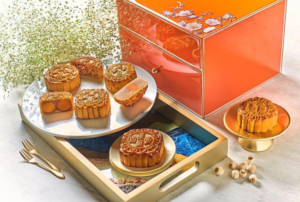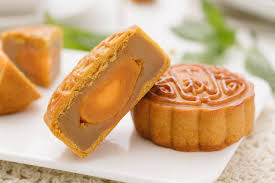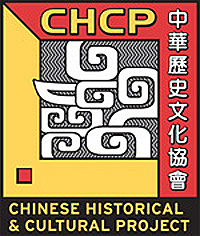|
- Home
- Moon Festival
Moon Festival
Fall is the season for Moon Festival parties. The event celebrates the harvest moon, when the crops have been gathered and heavy work in the fields is over. In 2001, the festival took place October 1, but preparations began weeks before.
The symbolism of various animals plays an important part in the ritual. For example, a carp that swam up the Yellow River through the Tung Kuan rapids and became a dragon will stimulate a scholar to put forth the effort to study to pass examinations. The butterfly conveys a wish for longevity and the red lobster brings mirth.
During the Moon Festival, all types of lanterns – and especially colorful, animal-shaped paper lanterns – decorate houses. Moon Festival altars are adorned with five dishes of round fruits, such as apples, peaches, pomegranates, grapes and small melons. The round shape symbolizes the moon, as well as family unity.

Another popular feature of the festival are moon cakes, which are stored in beautiful lacquer boxes constructed in various animal shapes. During the celebration, moon cakes are piled high – 13 in a pyramid – to represent the 13 lunar months in the Chinese calendar year.
Confectioners start baking the cakes, which are made with gray, moon-colored flour, as much as a month before the festival; in fact, some bakers make all their profits for the year from moon cake sales alone.
In Hong Kong and many parts of China, women join clubs with certain confectioners. The moment the Moon Festival is over, they start making small monthly contributions that accumulate in their accounts for the purchase of moon cakes the following season.
On the night of the festival, families gather to relax, give thanks, celebrate family unity and view the moon. A banquet is typically held at midnight.
Cloudy weather ruins enjoyment of the Moon Festival, and an eclipse is a disaster, but if all goes well, the event is alive with magical tradition, including music, dancing and worship, high energy and vivid decoration.
Reprinted with Permission by the Copyright Holder:
Man-U Import News
980 So. Amphlett Boulevard
San Mateo, California 94402
Autumn Harvest Moon Festival: Another Moon Festival Story
The Chinese celebration known as the Moon Festival is celebrated on the fifteenth day of the eighth month on the lunar calendar. On the lunar calendar, the first day of every month is the new moon, and the fifteenth day of every month is the day of the full moon. The fifteenth day of the lunar month usually corresponds to within one day of the full moon on the Gregorian/Western calendar. In the year 2000, the Moon Festival was on September 12.

As a child growing up in San Francisco’s Chinatown, I remember my mother buying moon cakes and bringing them home for us to eat. My favorite was the lotus root paste filling with the “1000 year old (fermented duck) egg” yolk. It had a taste of sweet from the lotus root paste and a taste of salt from the egg yolk. While growing up, I never really understood the meaning or the reasons for the celebration, but was just happy to eat the moon cakes.
With most Chinese, the Moon Festival is celebrated by going out at night and viewing the full moon and contemplating about the moon goddess/fairy that lives up there. While growing up, my father repeatedly told us another story, one of more historical significance, concerning the Moon Festival. I will try to repeat what he had told us.
Towards the end of the Yuan Dynasty (during the Mongolian rule of China, first established by Genghis Khan), the Han Chinese majority were tired of Mongolian rule. In the North, there lived a man by the surname of Zhu (or Chu in some Romanization schemes, and no relation to the author as Zhu was from a northern branch of the Chu/Gee family tree), who was the leader of a revolutionary group. The plans he made called for a signal during the Moon Festival for the revolutionaries to take the only knife allowed for every town and overthrow the Mongols. This signal ended up being a message placed in Moon Cakes, much in the same manner of fortune cookies of the modern day. After the overthrow of the Mongols, Zhu became the first emperor of the Ming Dynasty.
By Don S. Gee, Former CHCP Director
More About the Moon Festival
One of the CHCP board members compares the Moon Festival to the American Thanksgiving, an annual family get together.
The following is from Chinese Gastronomy by Hsiang Ju Lin and Tsuifeng Lin. Pyramid Communications, New York, 1972:
"The full moon, the crab, chrysanthemums and wine formed a poetic complement with some indulging in one, and others in the cakes shaped like the moon. Once again families exchanged near-identical gifts, buying these cakes from shops making essentially the same cakes, and giving them to each other.”
According to the authors, the moon cakes were filled with sweet red bean paste or crushed lotus seeds embedded with a salted cooked duck’s egg. They compare moon cakes to plum pudding and fruit cake, equally heavy English holiday traditions.

